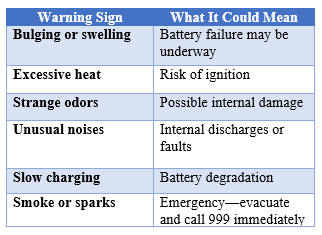
Section 21 vs Section 8: What Every Landlord Needs to Know
August 7, 2025
Mould and Condensation: 6 simple ways to stop mould this summer
August 28, 2025Key Points
- Lithium-ion batteries in e-scooters and e-bikes have caused a lot of house fires in the UK.
- Smoke alarms and heat detectors are legally required safety measures.
- Safe charging and storage habits significantly reduce fire risks.
- Why Noticing early warning indicators in batteries can stop calamities from happening.
- Fire blankets are essential for safely extinguishing small fires in the kitchen.
- Immediate evacuation and calling 999 are crucial in a fire emergency.
Here is the quick video:
Why Fire Safety Matters More Than Ever
With the rise of electric scooters, e-bikes, power banks, and other lithium-ion battery devices, the fire risk in residential settings has surged. In the UK alone, there were 211 fires caused by e-bikes and e-scooters in 2024, up from just two in 2017. Tragically, eight people lost their lives, and numerous fires broke out inside homes, especially in bedrooms, kitchens, and hallways.
Staying mindful of possible hazards and practicing simple daily safety routines can protect you, your home, and your peace of mind.
1. Smoke Alarms & Heat Detectors: Still Your First Line of Defence
UK law requires landlords to install:
- Ensure there is a smoke alarm installed on every level of the rental property.
- Fit a carbon monoxide detector in any room with a fixed combustion appliance.
- A kitchen heat alarm is highly advised to reduce false activations
Tenant tip: Test alarms monthly—if one doesn’t beep, report it immediately. Chronic false alarms or missing units are not just inconvenient—they’re unsafe.
2. Lithium-Ion Batteries: A Hidden Domestic Hazard
These batteries—powering e-scooters, e-bikes, gadgets, and more—can fail with devastating speed due to a phenomenon known as thermal runaway. This can lead to fiery explosions and toxic smoke, often catching residents off guard. Key risks include:
- Counterfeit or unregulated batteries
- Damaged or modified battery packs
- Charging indoors, especially overnight
- Storing units in escape routes or flammable zones
3. Safe Charging & Storage: At Home Precautions That Matter
Charging Safety:
- Use manufacturer-approved chargers only. Counterfeit chargers increase hazard risk.
- Never leave devices charging overnight. Stay alert and awake while charging.
- Place them on a sturdy, non-flammable surface, keeping them clear of fabrics and soft furnishings while charging.
Storage Best Practices:
- Store and charge batteries outside the main building—like in a shed or garage—if feasible.
- Never block escape routes or corridors with charging devices.
- Keep batteries cool, dry, and insulated from extreme temperatures.
4. Recognize Warning Signs Before It’s Too Late

5. Smother Fires Safely with a Fire Blanket
In kitchens, particularly:
- Keep a fire blanket within easy reach.
- In a fire, pull the tabs, hold it like a shield, and gently place it over the flame—cutting off oxygen.
- Remember: never use water on oil fires, which can spread the blaze.
Having this tool at home helps you stay calm in emergencies and minimizes potential damage.
6. Know What to Do if a Fire Breaks Out
- Evacuate immediately—don’t stop to gather belongings.
- From a safe outdoor location, call 999.
- Never go back inside a burning house, even if the fire seems to be under control.
Final Thoughts: Fire Safety Is a Shared Responsibility
Your home deserves modern conveniences—but not at the expense of safety. By combining regular alarm tests, careful charging habits, correct storage practices, and fire preparedness tools, you can dramatically reduce the risk of disaster in your home.
Stay vigilant, stay safe, and educate those around you. Fire safety isn’t just practical—it’s essential.

